An article of this nature cannot hope to cover every single plant or food source that can or can’t be fed to an animal. However there are some foods that are toxic to certain animals which humans consider healthy – like avocado.
If you have experience on a food source that is not good for animals or one that you have found to work in an emergency situation please add it in the comments section.
This article will cover what you can feed common domestic animals such as cats, dogs, horses, cattle, sheep, goats, chickens, guinea pigs, rabbits, and hamsters from your supplies or your survival garden, when stocks are running low in an emergency.
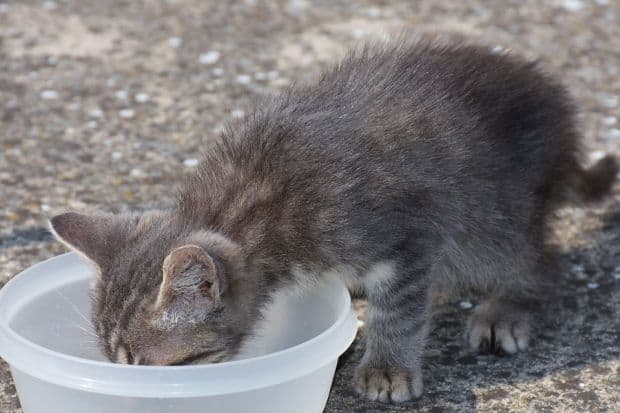
Cats
While cats seem to take a perverse pleasure in dumping freshly killed rodents, birds and lizards on their owner’s beds, this doesn’t necessarily mean they always eat their kill, and even if they do it may not always be good for them.
Often cats get very thin from eating lizards – the scales cause digestive problems and if the lizard is a big one the scales can damage the cat’s intestines. We provide a list of what cats can and can’t eat.
When we say “can’t” it doesn’t mean the cat will die immediately if you feed these products – in the long term you would rather avoid the items on the “don’t” list to ensure your pet’s long term health. Because the weather is bad and you’re stuck inside resist the temptation to share all your treats – it’s not doing them any good.
What you can feed your cat in an emergency:
Cats are meat eaters and need their protein, but you can feed from the list below
- Cooked chicken/turkey – no bones mixed with rice
- Cooked fish you may have caught – remove bones
- Cereals mixed with water or a meat broth, but avoid sugary cereals.
- Corn meal, polenta, or oats with chicken broth for flavor
- Canned soup
- Cooked mashed vegetables like pumpkin or butternut with a little chicken/meat broth
- Couscous with a gravy
- Tinned pilchards or other tinned fish
If a cat is really hungry and agile enough it will hunt birds and mice – essentially looking after itself when food is scarce, unless it is trapped indoors in a flood situation.
Don’t give your cat these items:
- Coffee, tea, and energy drinks may all contain caffeine, which is not good for cats, leading to muscle tremors, rapid breathing, and heart palpitations.
- Chocolate contains theobromine, a stimulant found in higher concentrations in dark and unsweetened chocolate, but it still occurs in milk chocolate and even white chocolate contains the stimulant, although in smaller quantities. Too much can lead to muscle tremors, seizures and heart problems.
- Alcohol can cause liver and brain damage in cats – so although you think you may be giving them a treat to lick a little from a saucer all you’re doing is setting yourself up for expensive vet bills later.
- Onion and garlic given on a regular basis cause problems as they contain an enzyme cats digestive systems are not set up for.
- Fat trimmings – too much fat for cats is bad and can lead to a painful condition known as pancreatisis.
- Grapes and raisins are bad for a cat’s kidneys – providing they do eat them – often they are contained in desserts or baked goodies and are not immediately noticeable. For example fruit cake is loaded with raisins.
- Milk and cream – although we think this is a treat and a cat will happily lap it up cats are lactose intolerant and their systems are not designed to deal with dairy products over long periods of time.
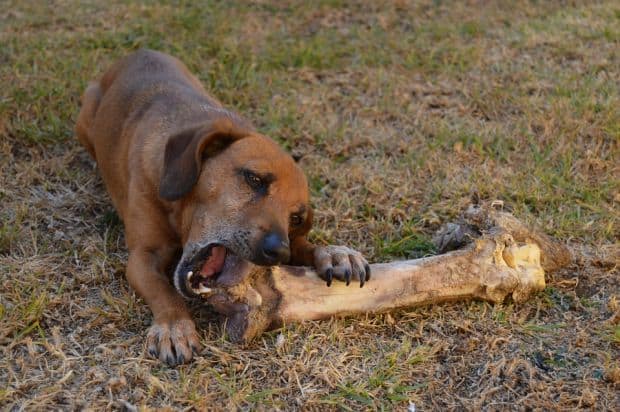
Dogs
Our furry friends love to share what we eat but they are meat eaters – not cookie monsters and we need to remember this.
Do give them:
- Lean meat – make sure you remove visible fat and the skin on poultry.
- Apple slices, oranges, bananas watermelon and peaches as well as mulberries can be fed if the dog likes them. We had a St Bernard who enjoyed peaches – walking round the trees each day to find the ripe peaches – unfortunately he tested quite a bit of unripe fruit that was then wasted. He also enjoyed fresh mulberries – coming in with his mouth stained purple when they were dropping off the trees.
- Potatoes – cooked, not raw can be fed in limited quantities. My vet has advised however that potatoes do nothing for the dog – they pass straight through the system – but at least they stop hunger pangs for a while.
- White rice is safe to feed especially with a chicken broth to flavor the rice. Brown rice contains a bit too much fiber for dogs. In places like Indonesia and Thailand dogs are fed a lot of rice, as the owners are vegetarian.
- Pasta can be eaten by dogs
- Peanut butter is enjoyable
- Carrot sticks if your dog will eat them.
- Corn but avoid giving him the cob– some dogs enjoy this, happily chewing off all those juicy kernels – others tend to turn up their noses.
- Beef, chicken or vegetable broth will be enjoyed by all dogs providing it is used to flavor bland food like rice or potatoes or cooked corn meal porridge. Do not give your dog broth that has onions in it!
- Cooked Pumpkin is a good extender if you don’t have dog pellets.
- Cooked Sweet Potato will likewise be enjoyed by the dog
- Butchers can provide cow and sheep heart, and lungs for you to cook up for your dog – they don’t look nice, nor do they smell nice, but the dogs will eat it.
- Dogs can be fed tinned minced pilchards – but their breath will be fishy
- Cooked corn meal porridge with a bit of meaty broth (that, again, should not contain onion)
Dogs are scavengers, however having said that, it doesn’t mean they can eat anything, There are certain items that make them sick.
Don’t feed your dog:
- Xylitol – if you have made drinks or food using this sweetener be aware and keep the food away from the dogs as it can cause a drop in the dog’s blood sugar levels,
- Moldy food – if it has mold on it throw it away safely where no stray can get ahold of it. If a dog contracts mycotoxin poisoning from the food they may die. Most times they won’t, but you don’t want to take the chance especially in an emergency situation where you may be stranded and not able to reach a vet.
- Avocado – it contains persin, which is fine for humans but can cause vomiting and diarrhea in a dog.
- Alcohol – sharing your drink with a dog may look cute but it is bad for the liver and brain.
- Onions and Garlic kill off red blood cells in a dog and can cause anemia. A little that is on your plate of food is ok but certainly not in quantity or on a regular basis. Watch out for sauces containing lots of onion or garlic – dog’s pick up on the meaty flavor if it was incorporated into a stew and will gulp it down.
- Coffee, tea, and caffeinated drinks. Dogs can’t break these down efficiently and in the long term caffeine can result in kidney damage
- Ice Cream and dairy products. Dogs need fairly bland food, so although sweetened ice cream and rich cream will appeal, but it is too rich for their digestive systems they’ll mostly just vomit it out. So those Instagram shots of dogs licking ice cream cones are not in their best interest. Too many dairy products can result in an allergy, which may cause excessive itching.
- Macadamia nuts– while oatmeal cookies may be fine to share, beware of anything containing macadamia nuts. The problem is compounded if you give the dog chocolate-coated macadamias. Although exactly why dogs are the only animals affected this way is not known, this article gives some background on macadamia nut poisoning in dogs
- Persimmons, peaches, plums, and apple seeds contain cyanide – the dog may chew up the seed, whereas humans know to spit them out, or if swallowed whole, they pass through the system. Sure, they won’t kill the dog immediately but you don’t want to cause long-term damage. If the dog eats fruit remove the stones/pips.
- Raw eggs – there is a danger of E. coli if you feed these to a dog. Most of the times it’s fine, but rather play safe and cook the eggs.
- Raw meat and especially fish could contain salmonella. Make sure what you feed them is fresh.
- Salty food like chips and pretzels can lead to sodium ion poisoning where the dog will vomit, have diarrhea and tremors. A few won’t hurt but don’t feed them on these in quantity.
- Sugar is bad for dogs in the long term leading to weight problems, tooth decay and diabetes, but a little now and then is not so bad – you can share an oatmeal cookie or two.
- Uncooked bread dough – if you feed them this in quantities the yeast rises in their stomach and can ferment making them ill.
- Nutmeg, baking soda, and baking powder are not good for dogs.
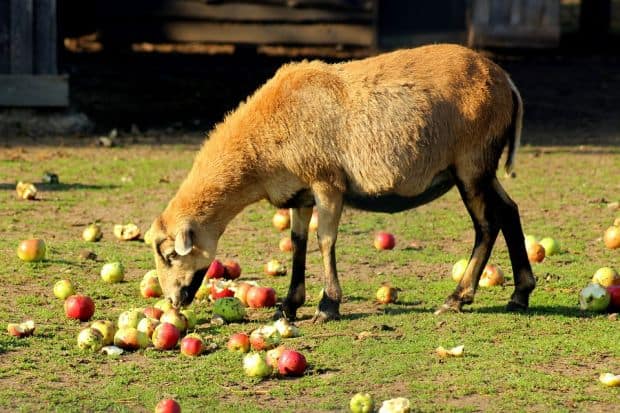
Sheep
Plan early for drought or hurricane conditions. Don’t let animals lose condition in the drought – bringing them back to prime health is more difficult once their systems are placed under stress, so buy in your supplementary feed early and get them used to it a bit at a time. Prices will shoot up when the drought deepens or the weather gets bad.
Hobby farmers tend to overstock resulting in the need for supplementary feeding, which can be a problem when bad weather hits or droughts occur.
>Sheep have four stomachs and the microbial composition of the rumen fluid in the first stomach adapts as feed changes. If you introduce new feed abruptly they can get sick – so introduce gradually, changing from dry feed to pasture to grain. Goats stomachs work the same way.
Do give your sheep:
- Carrots
- Grapes or leaves from the vines
- Fruit without the stones
- Clover, grass, forbs – it’s cheaper than buying in hay, grain and pellets.
Don’t:
- Let sheep loose in your garden to graze as it may do them more harm than good. Foxglove, rhododendrum, oleander, and privet hedge are just some of the plants that are toxic to sheep.
- Watch out for St John’s wort, yew, delphinium, laburnum, Iceland poppy, foxglove, cestrum, goat’s rue, blue lupin, and ragwort, as these can also be toxic.
- All parts of oaks trees – leaves, acorns, blossoms and buds are poisonous to sheep, cattle, goats, pigs, rabbits and guinea pigs – it’s the gallotannin that is responsible so make sure there are no oak trees where your livestock is pastured.
- Also don’t think you are doing them a favor by throwing garden clippings into their enclosure – some may be poisonous
- They will take bread, but it’s not particularly good for them – so keep bread treats to a minimum.
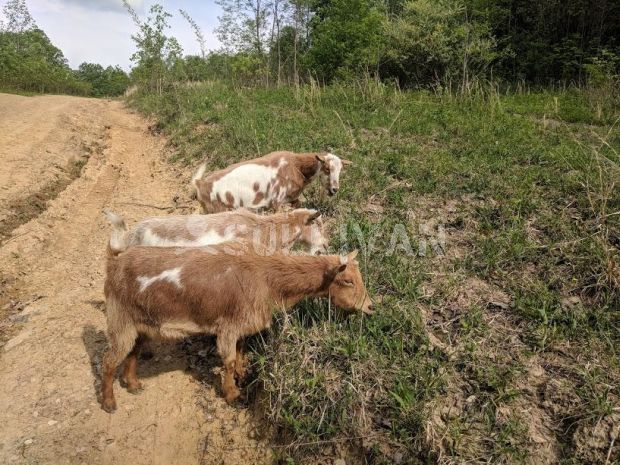
Goats
Goats have a reputation for eating everything and anything – including the washing off your line if they get a chance, but that doesn’t mean everything is good for them.
Goats can eat:
- Chaff haye – that’s alfalfa or grass cut early, chopped and sprayed with molasses to which is added bacillus subtillus. The mix is then vacuum sealed and ferments in the bag during which process good bacteria improve the food.
- Alfalfa hay
- Whole corn – but not too much – around 1 cup per day for adults and ½ a cup for kids. Make sure grain stores are secure because if they get in they will literally eat themselves to death.
- Sunflower seeds
- Beet pulp
- Rolled oats
- Fruit
- Dried fruit
- Graham crackers
- Cheerios
- Corn chips – but in moderation as they may be a bit too salty
- Kelp meal – in small quantities
- A nibble of rosemary or lemongrass won’t hurt them.
The safest is to let goats out to pasture – they will select what they need as they are browers, taking a bit here and there and moving on, so maybe one slightly toxic plant won’t matter. It’s a good idea to get goats from the local area – they have learnt through the other goats what should be avoided.
The problem can arise when a new one from a different area is introduced and doesn’t know all the local plants.
Don’t throw garden clippings into an enclosure unless you are sure what is in there as this is often where the problem comes in – the goats are confined in a space and eat what would normally be ignored if they had other choices.
Whatever you do, do not make big changes suddenly – and this can be tempting when floods hit and the goats have to be confined to higher ground or a small enclosure. The reason is that like sheep the bacteria in the goat’s rumen needs time to adjust.
So if you are in an area prone to hurricanes, then you know when hurricane season is approaching and can adjust the animal’s feeding a month or so in advance to prepare for the worst case scenario – then after the danger is over ease them back onto their natural pasture.
Don’t let your goats eat
- Avocado – the persin is the problem, as it is for dogs and many other animals
- Azaleas
- Chocolate – theobromine is the problem
- Plants from the brassica family like Kale – it contain oxalates, Cabbage belongs in this family of plants – some people feed it but it can cause bloat.
- Aubergines (egg plant), tomatoes, potatoes, peppers – in fact any vegetables that belong to the nightshade family. Now many people will say their goats eat some of these. Yes, maybe a few nibbles won’t kill them but rather stay on the safe side.
- Holly trees
- Oak leaves, acorns etc. otherwise they may get oak poisoning
- Lilly of the valley
- Lilacs
- Rhubarb leaves – the plant contains oxalic acid.
- Yew leaves
- Wilted cherry leaves
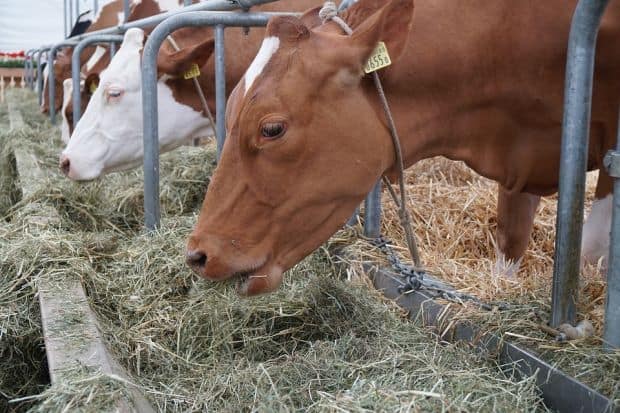
Cattle
You can feed:
- Sawdust contains cellulose and the bare minimum of nutrients and cattle will happily dig in. This article explains how farmers are feeding cattle sawdust.
- Kelp meal There has been controversy about seaweed in animal feed, but there are written records of the ancient Greeks gathering seaweed, washing it in clean water and spreading it out for the cattle to eat. Along the Transkei coast in Africa the cattle are frequently seen wandering the beaches – perhaps for the salt, perhaps for the odd nibble of seaweed. If you do have kelp meal feed it but only a little at a time until the animal has a chance to get used to it.
- Cornstalks
- Timothy grass, bluegrass, alfalfa, clover
- Corn, oats, soybean meal are not ideal for the digestive system but can be used if hay is scarce.
- If hay quality is low protein supplements can be given
Don’t give cattle:
- Plants from the brassica family – that includes broccoli, brussel sprouts, cabbage, cauliflower kale, collards, mustard, spinach.
- Oak leaves
- Yew
- Plants from the nightshade family – tomato, potato, aubergine, peppers – the leaves contain the toxin solanine. This article explains how a cow died within a week from being given tomato plants mixed in with its food.
This list from Cornell College of agriculture and Life Sciences details plants that are toxic to cattle.
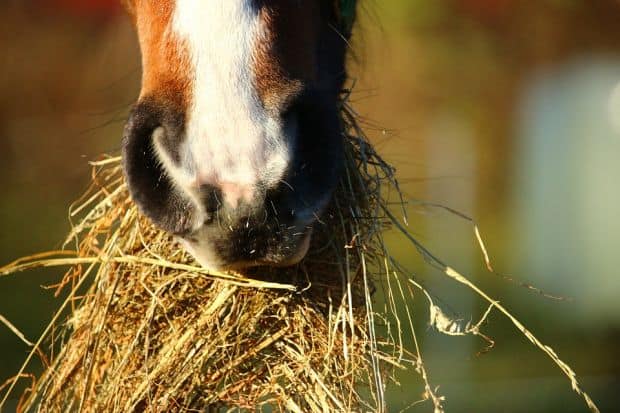
Horses
Horses eat around 1.5 to 2 % of their bodyweight per day – use this as a calculation when buying in and stockpiling food for flooding or drought conditions. Older hay, as long as it isn’t moldy, is clean and dustfree is OK to feed – if in doubt have it tested first.
Haynets are fine in good conditions – there is some wastage where the horses will pull it out and trample or soil it, but when it comes to conserving every bit of food in an emergency then rather put a piece of tarp on the ground and let the horse eat from that making sure they do not scatter the food. What is left can be picked up and fed to the horse later as it should still be clean.
When flooding is about to happen evacuate early with horses rather than risking leaving them isolated without food and clean water for days when floodwaters rise.
Always have your rations, medicines and water stored ready for use in an emergency at another location to which you might need to move the horses, or on the highest ground on your property.
Horses survive on hay or pasture. Feeding them grains and concentrates during an emergency can lead to colic – so always ensure you have reserved some hay for them.
Other snacks for horses:
- Horses can eat apples whole – the amount of cyanide in apple seeds isn’t going to kill them – unless they are munching down around 300 apples a day which is well nigh impossible.
- With peaches, plums etc. remove the pips or stones
- They like bananas – you can leave the peel on
- Orange and grapefruit will also be enjoyed
- Carrots
- Turnips
- Swedes
- Celery
- Beetroot
Watch out for:
- Oat straw – horses can get colic
- Beet pulp
- Soya bean hulls
- Rice bran
Don’t give horses:
- caffeinated drinks
- chocolate
- Garlic and onions
- Tomatoes, potatoes or any other fruit or parts of plants belonging to the nightshade family
- Dog or cat pellets – they contain meat and horses digestive systems are not set up for meat.
This article has some useful information on determining what to feed as per body weight, plus other useful tips when in a drought situation.
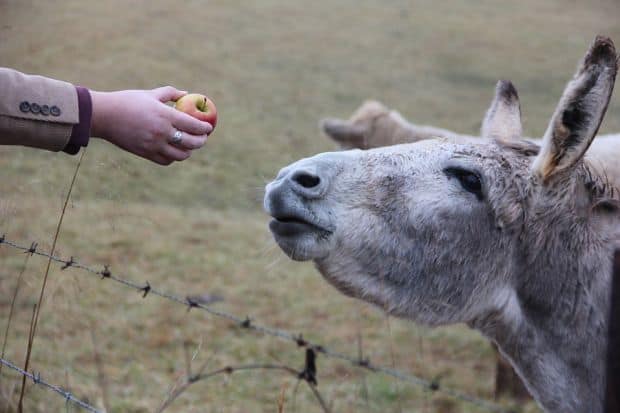
Donkeys
The animals survive in desert type conditions so over time their systems have evolved to extract every last bit of goodness out of what is available.
Do feed them
- Barley or oat straw
- Grass hay
- Timothy grass hay
- Carrots – as a treat
- Apples – as a treat
- Cereal like your oats or bran, even Weetbix
- Bananas
- Watermelon
- Pears
- Sweet potato
Avoid
- Alfalfa hay as it is very nutrient-rich
- Anything from the brassica family – broccoli, Brussels sprouts, cauliflower, cabbage, kale, boy choy, turnips, mustard, spinach
- Garlic
- Leeks
- Onions
- Potato – raw
- Stoned fruit like peaches, apricots and plums
- Anything fermented – like pineapple that is going “beery” – the fermentation makes the food toxic for the donkeys
- Moldy food – this is also toxic for them.
Here is some advice on feeding donkeys
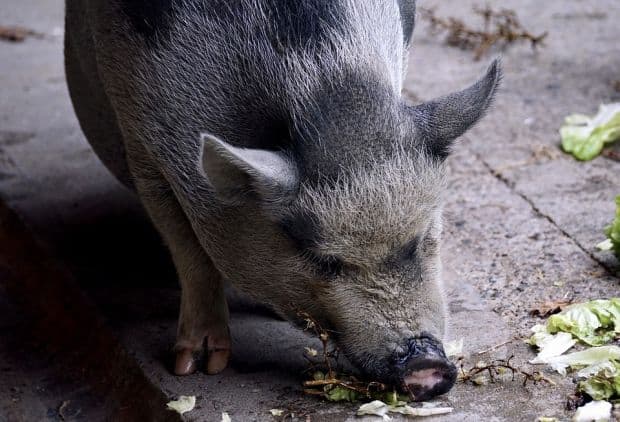
Pigs
Although the horror movies show us pigs eating human body parts don’t believe them – pigs should not be given any meat or fish. This article explains how feeding swill or leftover food that contains meat scraps can introduce devastating diseases to pigs.
What you can feed pigs
- Corn meal porridge
- Bread
- Most vegetables including pumpkin and sweet potatoes, turnips, swedes, carrots, beetroot
- Fruit – remove the stones from peaches, plums etc.
- Grass
- Nuts
- Berries
- Canned soup for very young piglets
- Oat porridge
Vary their diet and be careful of feeding too much cabbage.
What you should avoid feeding pigs:
- Meat
- Fish
- Green potatoes, tomato plants – nightshade family
- Rhubarb
You may find this article on poisonous plants helpful as it lays out the parts of the plant that affect horses, cattle, pigs, sheep, and goats. It even mentions here that cabbage roots and seed are poisonous to humans!
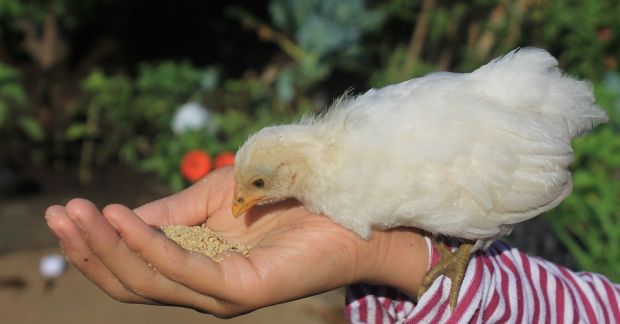
Chickens
To keep hens alive in an emergency is different to feeding them for optimum egg production. If they have some space to range freely they will help themselves to what they usually eat including insects, worms, various plants, seeds and bits of grass.
If you have to cage them then it’s more of a challenge. Hopefully you have stockpiled chicken feed and laying mash for emergencies but if these run out there are other options.
What you can feed:
- Apples
- Bran cereal
- Bread
- Cabbage – chopped
- Carrot – grated or chopped fine
- Cornmeal porridge
- Cornbread
- Cucumber
- Couscous
- Dog pellets softened with some water
- Eggs – boiled and chopped. Yes chickens are cannibals!
- Lettuce
- Meat scraps from your plate including chicken.
- Oats – cooked
- Pasta
- Peach –remove stones/seed
- Pear
- Potato cooked
- Pumpkin
- Rice – cooked
- Sunflower seed
- Sweet potato
- Weetbix
- Weeds and herbs
If you have aloe vera growing in your garden or as a pot plant in cooler climate, squeeze a little from a cut leaf into their water as it can help prevent some of the diseases chickens are prone to getting – it’s an African tradition where local subsistence farmers don’t have access to expensive medication. It should be used as a preventative, as if you give it when the chicken is already severely infected it may be too late.
This article mentions that in the Philippines aloe vera resulted in better weight on broilers, and it lists the minerals and vitamins found in the plant.
What shouldn’t be fed to chickens:
- Avocado pear –contains persin a fungicidal toxin in the seed, which can leach into the flesh. A small amount of avo in leftovers from plates isn’t going to hurt. Just don’t feed large quanitites of avo!
- Citrus fruit –some people do feed – it is however acidic and will cause loose droppings, but in small quantities shouldn’t hurt them
- Potato peels or raw potato – especially the green ones
- Green tomatoes/tomato plants/ aubergine plants – nightshade family
- Dried or raw beans
- Holly berries
- Mistletoe
- Overly Salty food, like crisps from a bag in quantity – sharing a crisp or two with a chicken wont hurt.
- Nutmeg contains a toxin called myristicin – if you used nutmeg to flavor your food and are feeding leftovers that should be ok – just don’t give them large quantities.
- Chocolate – seriously who is going to share this with chickens – but if you think about it – don’t because theobromine contained in chocolate can be toxic in excess.
- Alcohol – leftover beer or wine in the bottom of the glass? Chuck it, but not to the chickens – it’s not good for their livers.
- Onions and garlic given in quantity may give the eggs a strange flavor – but if it’s a little in food it should be fine.
- Moldy food
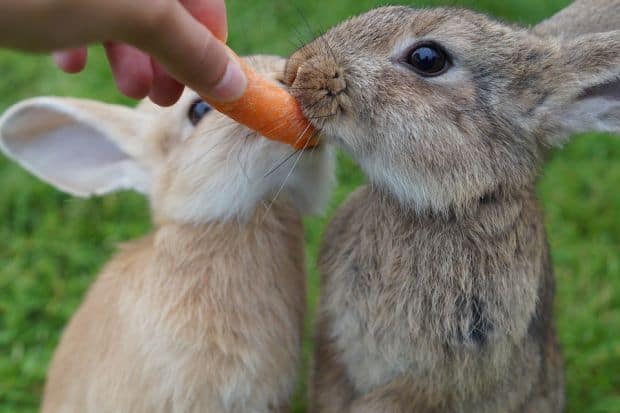
Rabbits and Guinea Pigs
These herbivores need plenty of fiber in their diets as their teeth grow continuously and they need to do lots of chewing to keep their teeth in shape. If their food is too soft their teeth grow too long so they can’t chew and starve to death!
Make sure they are supplied with grass and timothy hay, and even wood to gnaw on. In fact grass and hay should constitute about 80% of the diet with other little fruit treats given.
You can feed them
- Pellets designed for rabbits or guinea pigs
- Hay
- Fresh grass
- Pumpkin
- Carrots
- Apples – remove the seeds that contain cyanide
- Pears
- Banana
- Celery
- Cucumber
This short video tells you what guinea pigs should and shouldn’t eat and gives plenty of options:
And this one details what rabbits can eat:
Don’t feed your rabbit or guinea pig these:
- Dog or cat pellets – their digestive system is not set up for meat.
- Dairy products – no milk, yoghurt, cheese or eggs – they are not set up to digest these either and over time they will get sick. They will be ok in the beginning but the damage takes a long time to show – and then it will be too late.
- Cabbage and cauliflower – yes people feed these but they can cause bloat – rather avoid them.
- Avocados – rabbits and guinea pigs need roughage and the soft flesh, is not providing the roughage they need, besides they cannot deal with the persin, a toxin that leaches into the flesh from the seed of the avocado.
- Onions, leeks, chives, garlic – these all belong to the alium family and as with cats and dogs, are not good for rabbits and guinea pigs.
- Raw beans give them gas – leading to bloat.
- Rhubarb contains oxalic acid and is a no-no.
- Iceberg lettuce and other soft lettuces can cause diarrhea.
- Bread, biscuits, sweets, and breakfast cereals should be avoided as should chocolate (contains theobromine).
- Plants belonging to the nightshade family should be avoided like tomato tops, potato leaves, pepper plant, and aubergine leaves.
- Potatoes
- Popcorn – it can get stuck in their throats
- Lily of the valley is poisonous to them and don’t give clippings from garden shrubs
They are small animals and in nature cannot reach very high –so their natural diet is confined to grass, herbs, some vegetables, plus some fruit that may blow off trees.
You probably will have noticed that they are not averse to eating their wood shaving bedding, any paper they can get their teeth near, and their wooden cages. Well, wood is natural and keeps their teeth short so it’s better than chewing plastic! Just make sure paper used to line their cages isn’t covered in lots of printer’s ink – plain brown paper is best if they are going to insist on eating it. Hamsters also have a tendency to chew everything.
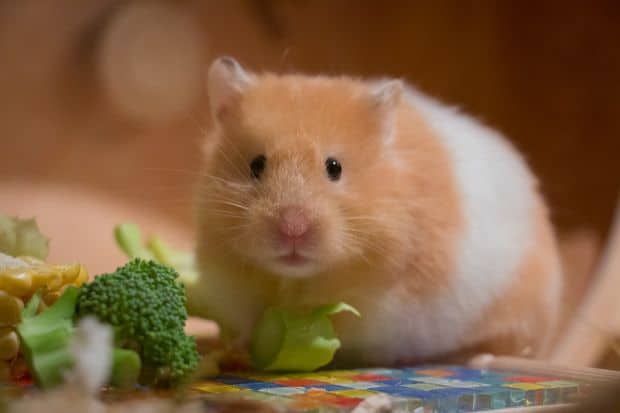
Hamsters
These are very tiny creatures and they are omnivores –eating both meat and plant items, so feed small amounts that are varied in nature to ensure a balance. It is important to wash fruit and vegetables to ensure there are no pesticide residues, which could make them ill, and just feed them a tiny chunk of fruit – too much can cause diarrhea.
Water should be fresh and if there is fluoride or chlorine in your water rather give them pure bottled spring water. Don’t leave food to go off in the cage – clean out regularly. Only feed what they need – you’ll have very fat hamsters if they are left to help themselves to a buffet all day long.
Do feed them:
- Apple
- Banana
- Basil
- Blackberries
- Blueberries
- Boy choy
- Broccoli
- Brussel Sprouts
- Cabbage
- Cantaloupe melon
- Carrot – not too much as it is sweet
- Cauliflower
- Chicken cooked
- Cilantro
- Celery
- Cherries – remove stones
- Cucumber
- Egg – scrambled or boiled
- Endives
- Grapes – remove seeds
- Grass
- Grains – like oats or barley
- Green beans
- Hay
- Kale
- Kiwi fruit
- Mango
- Parsley
- Parsnips
- Pear
- Peas
- Peach
- Potato cooked
- Pumpkin
- Raspberries
- Romaine lettuce
- Seeds –like sunflower
- Spinach
- Strawberries
- Sweetcorn
- Tomato minus the seeds
- Turnip
- Watermelon
Avoid:
- Avocado
- Bacon
- Candy
- Chives
- Chilli
- Citrus fruit – orange, grapefruit etc. – acidic and can give them diarrhea
- Garlic
- Ham
- Iceberg lettuce
- Kidney beans – toxic
- Onion
- Potatoes – raw – toxic
- Pickles
- Spices and seasonings.
This video shows you what you can and can’t feed hamsters:
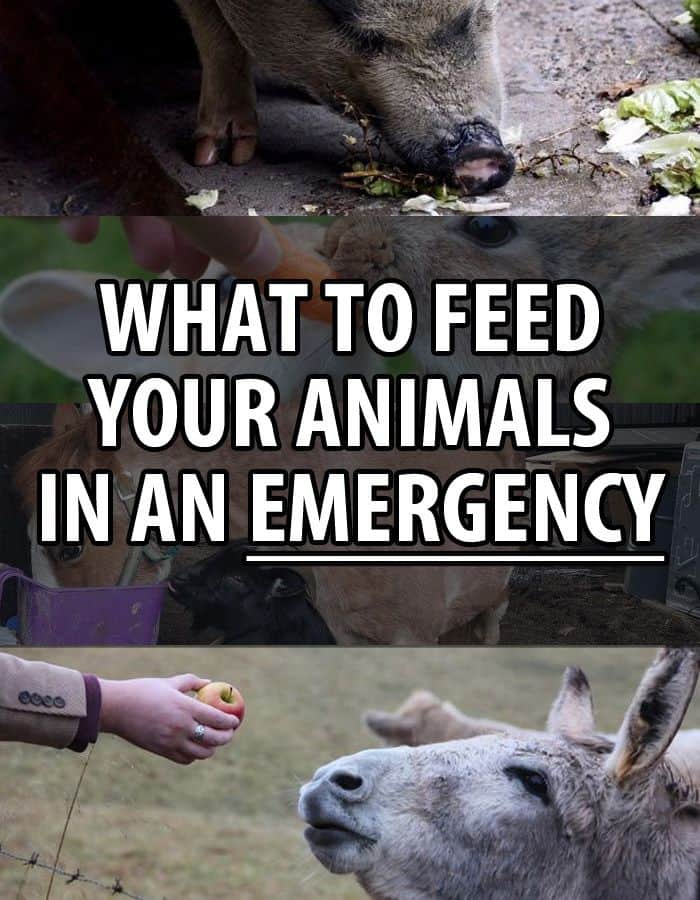

Traveler, photographer, writer. I’m eternally curious, in love with the natural world. How people can survive in harmony with nature has fueled my food safety and survival gardening practices.
At the age of 12, I found a newspaper advertisement for a 155-acre farm at a really good price and showed my parents one Sunday morning. They bought it and I happily started planting vegetables, peanuts, maize and keeping bees with the help of the local labor.
Once I married wherever we moved it was all about planting food, keeping chickens and ducks, permaculture and creating micro-climates. I learned how to build wooden cabins and outdoor furniture from pallets, and baked and cooked home-grown produce, developing recipes as I went along.

Thank You for this very important information on what to feed our furry and feathered friends in an emergency.
Just want to let you know. While dogs may like corn. The cob should never be given to a dog. They can not digest it. If the chew it well, may not have problems. But if they don’t, it can become a blockage that has to be surgically removed. Not worth the risk.
First hand experience.
Most brands of broth, both beef and chicken contain onion. I haven’t seen one in the grocery store that does not. Perhaps homemade is ok, if no adverse ingredients are used, but commercial brand are not safe, for dogs, anyway.
Very extensive article… Folks, this should be printed and put into your SHTF Important Information binder (Double sided to save paper/money)… I will say this about 98% of the animals posted on this forum.. Animals know (sense) what is edible and what is not.. If you throw a bucket of kitchen scraps in to the yard for the chickens, you can watch them scratch through it avoiding all non edibles (like onions). Most animals do the same in the sense of food they can or cannot eat. Respectfully, The Break Away Homesteader.
Thanks for the extensive list. It looks like a great resource for animal owners in general, not just for emergencies. I agree with Patrick B., it’s something that should be printed out and kept handy. Blessings!
In addition to my previous comment, grapes/raisins are absolutely NOT safe for dogs, whether or not you remove seeds. Please, please, update the list.
Thanks for the comments everyone, I’ve just updated the article.
Rabbits don’t really eat carrots.
It’s a myth created by a certain cartoon.
In fact, they’re an unhealthy choice and can kill the animal.
https://www.rspca.org.uk/adviceandwelfare/pets/rabbits/diet/myths